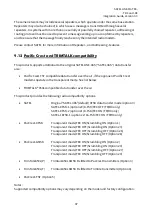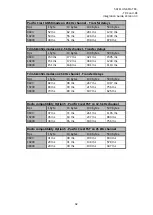
SATELLINE-M3-TR3,
–
TR4 and -R4
Integration Guide, Version 3.0
39
The configuration tools and settings are different between SATELLINE and Pacific Crest
modems:
Pacific Crest modems are configured via the serial port using PDLCONF WindowsTM program
that sends binary control messages to the serial port of the modem.
SATELLINE-EASy radio modems are configured via the serial port using SL commands or SATEL
Configuration Manager PC-program.
The table below shows the analogy of settings between Pacific Crest and SATELLINE radio
modems.
Pacific Crest setting
Corresponding SATELLINE setting
Identification: Owner
not implemented
Identification: Channel Bandwidth
Channel spacing
Identification: RF Power
TX power
Radio Link: Channel Selection Type
(Manual)
Radio frequency
Radio Link: Current Channel
Radio frequency
Radio Link: Link Rate
Radio compatibility mode and channel
spacing determine the link rate
Radio Link:Modulation Mode
Radio compatibility
Radio Link:Scrambling
ON by default
Radio Link:Transmit Retries
not implemented
Radio Link:TX ACK Timeout
not implemented
Radio Link:Csma Monitoring
Priority (RX=ON, TX=OFF) Default: RX
Radio Link: AutoBase/AutoRover
not implemented
Radio Link:Digisquelch
Signal threshold
Radio Link:Forward Error Correction
ON by default
Note: SATELLINE-EASy FEC must be OFF!
Radio Link:Local Address (0 by default)
Primary RX address (RX1) (OFF by default)
Radio Link:Remote Address (255 by default) Primary TX address (TX1) (OFF by default)
Serial Interface:Protocol Mode
Radio compatibility
Serial Interface:BREAK to Command
not implemented
Serial Interface:Modem Enable: Yes
not applicable
Serial Interface:Soft Break Enable
not implemented
Serial Interface:EOT value (in 0.01s units)
Pause length (in serial port byte intervals)
Serial Interface:Digipeater Delay
not implemented
Serial Interface:Local Node Repeater
not implemented
Frequency Table
Radio frequency
Data Security Code (must be 0=not used)
not implemented
Potential conflicts:
















































